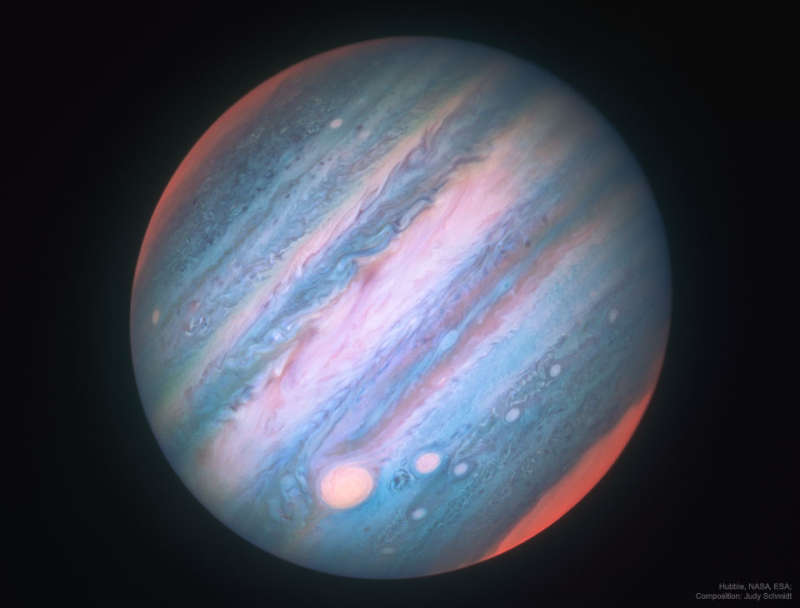Credit & Copyright: NASA,
ESA,
Hubble;
Data:
Michael Wong
(UC Berkeley)
et al.;
Processing &
License:
Judy Schmidt
Explanation:
Jupiter looks a bit different in infrared light.
To better understand
Jupiter's cloud motions and to help NASA's robotic
Juno spacecraft understand the
Hubble Space Telescope is being directed to
regularly image the entire Jovian giant.
The colors of Jupiter
being monitored go beyond the normal human visual range to include both
ultraviolet and
infrared light.
Featured here in 2016, three bands of near-infrared light have been digitally reassigned into a mapped color image.
Jupiter appears
different in infrared
partly because the amount of sunlight reflected back is distinct,
giving differing cloud heights and latitudes discrepant brightnesess.
Nevertheless, many familiar features on
Jupiter remain, including the
light zones and dark belts that circle the planet near the equator, the
Great Red Spot on the lower left, and the
string-of-pearls
storm systems south of the Great Red Spot.
The poles glow because high altitute haze there is energized by charged
particles from Jupiter's
magnetosphere.
Juno has now completed
10 of 12 planned science orbits of Jupiter and continues to record data that
are helping humanity to
understand not only Jupiter's weather but
what lies beneath Jupiter's thick clouds.
1999 2000 2001 2002 2003 2004 2005 2006 2007 2008 2009 2010 2011 2012 2013 2014 2015 2016 2017 2018 2019 2020 2021 2022 2023 2024 2025 |
Январь Февраль Март Апрель Май Июнь Июль Август Сентябрь Октябрь Ноябрь Декабрь |
NASA Web Site Statements, Warnings, and Disclaimers
NASA Official: Jay Norris. Specific rights apply.
A service of: LHEA at NASA / GSFC
& Michigan Tech. U.
|
Публикации с ключевыми словами:
Jupiter - infrared - Юпитер - инфракрасное излучение
Публикации со словами: Jupiter - infrared - Юпитер - инфракрасное излучение | |
См. также:
Все публикации на ту же тему >> | |
